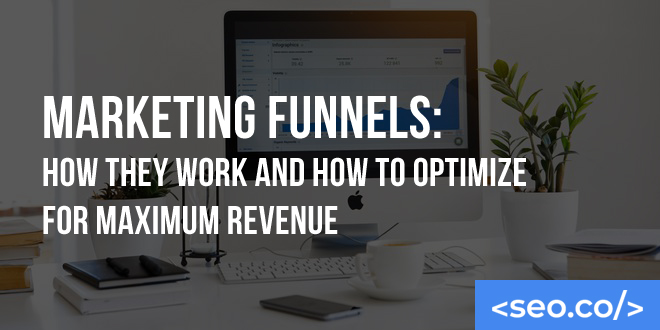Small businesses – and many medium-sized businesses, for that matter – often have very good ideas, well-developed products, and high quality services. Yet they fail to gain visibility or traction. What gives?
While a lack of results could be tied to thousands of company-specific factors and circumstances, it’s often underscored by one simple reality:
Most businesses don’t have a plan for how they market their products and services to prospects.
And if they do have a plan, it’s not optimized in a way that works with the basic psychology of how people shop for products and make decisions.
Whether it’s impatience or ineptitude depends on the business, but most companies are unwilling to put in the work it takes for marketing qualified leads. They’d rather earn a quick sale. (Unfortunately, this mindset often comes at the expense of losing many qualified leads who would have otherwise been quite valuable.)
What’s the solution?
Well, it’s actually quite simple and sensical – once you understand how it works.
And once you wrap your mind around the correct method of nurturing prospects and converting them into loyal customers, you’ll realize that all businesses ultimately work the same way.
In this article, we’re going to discuss marketing funnels, what they are, how they work, and what it takes to generate content that moves people through your funnel – ultimately resulting in sales.
Does that make you tingle with excitement?
Table of Contents
What is a Marketing Funnel?
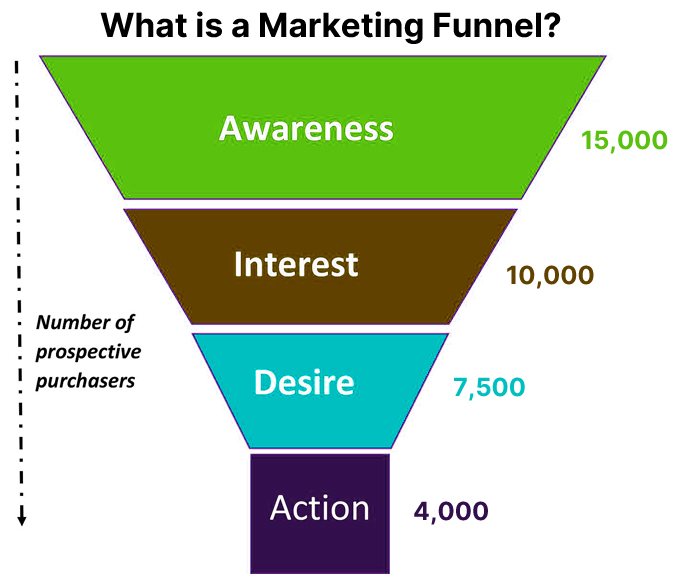
Let’s begin with the basics.
A traditional marketing funnel is essentially a visualization for understanding the processes that take place when a prospect turns into a customer (through a sales lens).
The basic gist is this: A prospect has no clue that your business exists. She then becomes aware of your business and its products, interest is sparked, she evaluates whether she likes your products (in the context of other marketplace options), decides to make a purchase, and ultimately follows through by exchanging money in return for what you’re offering.
It’s called a marketing funnel because of how the number of leads ultimately gets smaller and smaller until only the most qualified are left.
You might have a pool of 15,000 people who are aware of your product, but only 10,000 of them are interested.
Out of this group, just 7,500 take the time and effort to evaluate your product. In other words, they make it down through the bottom of the marketing funnel.
And of these, 4,000 make a purchase.
The funnel moves prospects through a sensical step-by-step process that weeds out the disqualified and disinterested, while nurturing those who are interested and likely to become paying customers. (In this sense, it’s an efficient process for both parties.)
While this sounds super formal and rigid, a good marketing funnel is invisible to your prospects.
To them, it’s all engagement.
It starts slow and surface-level and begins moving faster into a more detailed and refined direction. Before they know it, they’re sliding down your well-oiled funnel – ready to open up their wallets and purchase what you’re offering.
The 5 Stages of the Sales Funnel
Every marketing and sales funnel has its own nuances and steps, but they all follow five basic stages. That’s because all human psychology is basically the same. People might seem different – and in many regards they are – but customers tend to act in predictable and repeatable ways. Thus dividing the sales funnel into five clean stages serves as an effective way to standardize the process.
We’ll discuss specific ways to target customers in each of these stages with high-converting content in the next section. For now, let’s get a clear understanding of what’s happening in each of them (from the perspective of the customer).
Stage 1: Problem/Need Recognition
It’s during this first stage that people become aware of the fact that they have a problem. This is the top of the funnel. (Prior to this point, an individual isn’t actually in your funnel to begin with. They have no issue, so there’s nothing you can do for them.)
Examples of customers entering into the problem or need recognition stage include:
- A homeowner’s AC stops working in the dead of summer and he suddenly realizes that he needs something fixed or replaced in his system.
- A busy mom hops in her van in the morning to carpool her kids to school and it won’t start. She clearly has a problem and a need.
- A freelancer gets fed up overpaying on his taxes. He figures there must be a better way, but he doesn’t know what that is.
- A college student is frustrated by the poor picture quality of his TV and begins wondering if there are better TVs on the market that are within his budget.
There’s no active searching going on in this phase. Customers in this phase are just realizing they have an issue or need. They’re on the front end of the process.
Stage 2: Information Search
While some people will live with a problem or need for days, weeks, months, or even years before taking action, most will seek to alleviate or solve it as quickly as possible. This leads them into the information search stage. This phase puts the user higher in the top of the marketing funnel.
During the information search stage, prospects gather information, explore the products and solutions that exist, gather information about different companies, get prices, ask questions, read reviews, browse Google, etc. This is also the phase where many would-be marketers tend to find and focus on vanity metrics and not conversions, which happen later. While top-of-the-marketing-funnel metrics can prove helpful to later success, they are not success in and of themselves alone.
Depending on a prospect’s personality and the severity of the problem or need, this information search can be fast (minutes) or extensive (months). Using our four examples above, here’s what the information stage might look like:
- The homeowner Googles possible problems that could be causing his AC unit to not work properly. He reads various online forums, watches a couple of YouTube videos, and even calls a handy friend to ask questions.
- The busy mom puts out a Facebook post asking her friends for advice on what to do when a Honda van won’t start.
- The freelancer visits a few freelancer message boards and Reddit pages to figure out how much most of his peers are paying in taxes, how they get their taxes filed, and what their recommendations are.
- The college student heads over to a couple of major ecommerce sites and searches for TVs that fit his parameters (screen size, technology, brand, and price range).
These information searches ultimately lead the customer to different companies and professionals
Stage 3: Evaluation of Alternatives
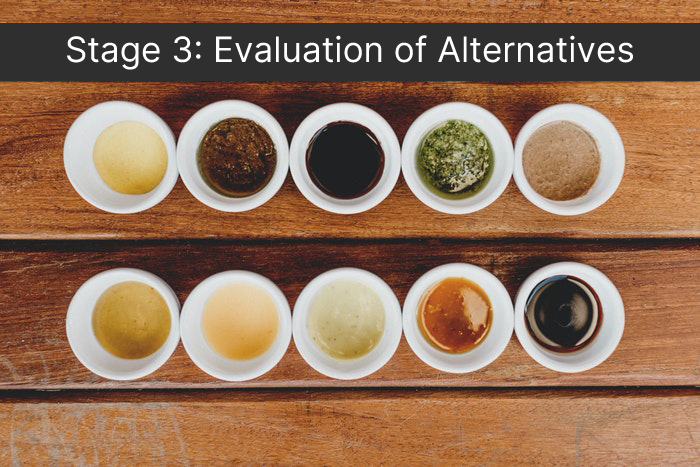
Now a customer is really in the thick of it. They’ve identified that they have a problem and they’ve researched the products and services that exist to solve their problem or smooth over their various points of friction. It’s at this point in the game that multiple options are compared and evaluated against one another.
The evaluation phase is often the most time-consuming – particularly if there are divergent choices and/or the customer is indecisive.
The lower the price point and/or less important the outcome, the faster a prospect moves from stage three to stage four. For example, choosing between Chick-fil-a and Subway for lunch takes just a couple of minutes.
The higher the price point and/or more important the outcome, the longer it takes for a prospect to move from stage three to stage four. For example, choosing the right type of setup for an aging parent (assisted living, nursing home, in-home health aide, etc.) could take months.
Using our illustrations:
- The homeowner considers whether he should have an HVAC technician come in and repair his AC unit at a cost of $750 or go ahead and spend $4,500 to replace the unit with warranties that will cover any future breakdowns.
- The busy mom decides whether to jump her car herself, call a mechanic to come start her battery, or replace her battery. And if she’s going to replace her battery, she figures out the best type of battery that fits within her budget.
- The freelancer decides between DIY tax filing with a software like TurboTax and switching accountants. (If going the latter route, he makes a list of three accountants in the area and compares each of them.)
- The college student makes a spreadsheet with four of his favorite TV options and compares features and prices from different retailers.
Every prospect is different, but this gives you an idea of how they think when solving problems. There’s rarely one choice. There’s almost always two or more options (and sometimes dozens).
Stage 4: Purchase Decision
Your prospect has successfully entered stage four of the funnel. And this is where a purchase decision is made.
The purchase decision is the natural result of the three stages that precede it. At this phase of the game, a customer is ready to pull out the wallet and swipe the plastic.
Think of this stage like a football field. You’ve already marched 99 yards down the field. Now it’s first and goal from the one-inch line. While it’s technically possible that you don’t score, all you need to do is push the football over the line. A little more effort and no major mistakes (fumble) is all it takes.
Back to our illustrations:
- The homeowner calls up the preferred HVAC company and asks one final question to clarify something about payment or scheduling.
- The busy mom contacts a local mechanic and inquires about how to schedule someone to come out and replace her battery.
- The freelancer decides to go with TurboTax and visits the website to complete the purchase.
- The college student picks a TV model and goes to Amazon to click the “add to cart” button.
At this stage, the customer is looking to finalize the decision in a purchase. However, they have an expectation that everything will go smoothly. Any unforeseen friction can push the customer back into stage three.
Stage 5: Post Purchase Behavior

After making a purchase, the customer wants to know that they’ve made the right decision. And if they have made the right decision, they’ll want to tell people about it. (The same goes if they feel regret about their purchase decision.)
Here are some examples of what could happen:
- The homeowner is thrilled with the service provided by the HVAC company and posts a positive Google Review.
- The busy mom feels like she got ripped off by the mechanic and tells all of her friends to stay away from the company.
- The freelancer ends up saving a small amount of money with TurboTax. He researchers other options and finds that he can upgrade to a premium product and possibly save 10 percent more on his taxes next year.
- The college student loves his TV so much that, after graduation, he purchases another one (this time bigger!) for his first house.
Again, there are so many different options here. But this should give you a basic idea of what’s happening after purchase and why it matters so much.
Creating High-Conversion Content for Each State
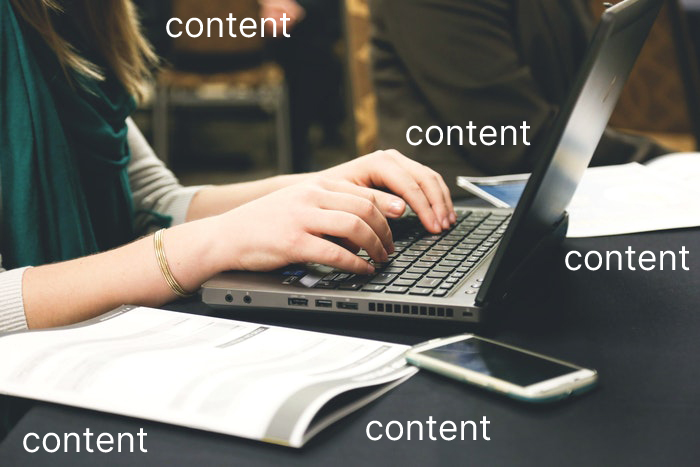
Okay, now that we have a clear handle on what the funnel looks like and how people move from awareness of a problem to a purchase decision, let’s explore the role of content in this process.
In other words, how can you create high-converting content that greases the funnel, addresses prospects at each stage, and ultimately pushes them further and further down until they make a purchase?
Here’s a closer look.
Stage 1 Content (Problem/Need Recognition)
The most effective marketing campaigns use content to make people aware of their problem and help them see that they have a need.
Common content options in this stage are articles, digital advertising campaigns, webinars, podcasts, and paid search leading to landing pages.
As tempting as it may be to shove your product down a prospect’s throat or go in for a quick sale, this stage is all about laying the groundwork. You are helping them see that they have a problem or reassuring them that their need is a valid one.
Stage 2 Content (Information Search)
In stage two, the prospect is interested in finding a solution and actively working toward finding information to assist in solving the problem they face.
Good content options include website content, social media posts, blogs, newsletters, and targeted email campaigns.
Guest blog posts are especially helpful during this stage (as well as the next one). They’re seen as unbiased and helpful. Webinars are great because they’re able to go in-depth and build trust. Get creative!
Stage 3 Content (Evaluation of Alternatives)
At this stage of the game, a prospect has some information. They’ve become a mini “expert” on the topic and are ready to evaluate all of the options and alternatives.
Your content should center on establishing your product or solution as the best. You can do this in a positive way (amplifying your brand and using social proof to explain why you’re the best), or in a less positive way (explaining why the competition can’t match up and/or why alternative options are a mistake).
Content commonly used in this phase include white papers, ebooks, brochures, and PDF guides.
Stage 4 Content (Purchase Decision)
It’s purchase time. If you’ll remember from our previous discussion on stage four of the marketing funnel, you’re on the one yard line. All you need is one final push. Don’t mess it up!
Good content for this stage is safe and encouraging. The more specific you can be, the better. We’re talking about case studies, testimonials, data sheets, etc. You want to remind the prospect why they’ve decided to purchase from you.
Stage 5 Content (Post Purchase Behavior)
We’re not going to spend much time discussing stage five, but this is still an important one – particularly for subscription-based businesses and other brands that rely on repeat purchases.
During this phase, the goal is to wow customers, reassure them that they made the right choice, and attempt to upsell or cross-sell.
If you have an email list, this is a good time to slow drip them with the occasional social proof or case study that shows other customers are enjoying the products as well. You want to reassure them and encourage them to purchase again in the future.
If you have some sort of tiered business model with a low-price, mid-price, and premium-price, the objective is to move them up the tiers until they become the most profitable customer they can be.
Test Absolutely Everything
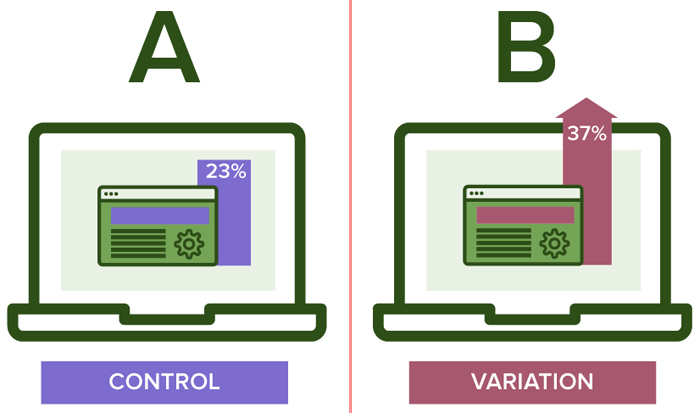
This is a basic overview of what a marketing funnel looks like and how the right content moves people to action. But it’s important to remember that every business and target audience has its nuances. This is why testing is so valuable.
Once you get your funnel in place, the real work begins.
You need to isolate the key elements in each stage and test how they’re performing in order that you can optimize and iterate.
Here are a few thoughts and ideas to get you moving:
- Create Conversion Funnels on Google Analytics. If you really want to be successful with marketing funnels and content marketing strategy, take some time to learn the ins and outs of Google Analytics. It’ll take you a weekend to get the basics down and you’ll see tremendous fruit from the investment of time. Using your knowledge of Google Analytics, set up a “Goal Funnel” to track where users are abandoning your conversion funnel. You can refine your approach based on this data.
- Carefully Analyze and Optimize Landing Pages. Your landing page plays a key role in moving people from one stage of the marketing funnel to the next. Always analyze and optimize landing pages. (This includes elements like headlines, copy, color, font size, and purchase path.) You can use A/B testing to figure out the best combinations.
- Refine Your CTAs. How are you moving people through the funnel? What calls-to-action are you using? How can you improve them to get better results?
- Analyze and Optimize Sign Up Forms. Sign-up forms are very important. They often mean the difference between losing someone at stage one of the funnel and seeing them through to stage five. Study best practices, track what your data, and optimize until you reach your benchmarks.
- Test Out Different Trust Signals. Trust signals are valuable – particularly in the later stages of your funnel. At a bare minimum, you need to incorporate and test guarantees, authoritative logos, and reviews/ratings.
You can’t set a marketing funnel and forget it. Testing is where the magic happens. Don’t be frustrated if your first crack at developing a funnel produces minimal results.
Through regular testing optimization, and iteration, you’ll eventually get to where you need to be.
Scale Your Organic Traffic With the Highest Quality Content and Links
Marketing can look complex when you view it from the outside looking in. But once you get up close and personal – breaking it down into digestible bits, processes, and marketing funnel stages – it becomes much more approachable.
The hope is that this article has pushed air under your wings. That you feel empowered to tackle marketing in an effective capacity – once and for all.
But we also understand that you may not have the time or internal resources to handle all of it on your own. And that’s totally fine, as well.
At SEO.co, it’s our aim to help you with some of the heavy lifting. As your SEO company we want to assist you in pushing prospects from the awareness stage all the way through the marketing funnel and into the sales stage of your customer journey. We do this by scaling organic traffic with the highest quality content and links on the web.
Want to learn more about our content writing and link building services?
If you need the most advanced, up-to-date and effective marketing tactics to take potential customers into repeat customers that love your product, we’re the team for you.
We’d love to hear from you – contact us today!
- Guest Blogging Services: How to Assess the Quality of Guest Post Services - January 24, 2024
- Are .gov and .edu Backlinks Valuable for SEO in 2024? - December 26, 2023
- SEO Linkgraph: 21 Steps to Keep a Clean Backlink Footprint - October 30, 2023

